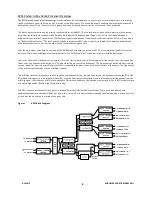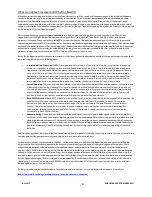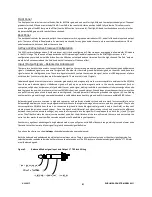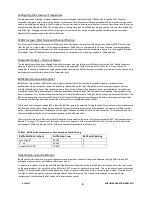
8/22/2017
SUBLIME ACOUSTIC MODEL K231
4
Front Panel
The front panel contains four control knobs; One for BSC filter gain, and one each for High, Mid, and Low output channel gains. The panel
gradients for the BSC knob are marked off in dB, from 0dB in the counter-clockwise position to 6dB fully clockwise. This allows you to
control the gain of the BSC low pass shelf filter (see the BSC section for more info). The High, Mid and Low knobs have a small circle that
indicates the 0dB gain point for each of these channels.
Back Panel
The back panel contains the power input jack, the main power switch, a green power indicator LED, and all of the audio input and output
jacks. These are all fairly self explanatory. As previously mentioned, for any given audio channel, only connect a balanced source OR an
unbalanced source, but never both at the same time.
3-Way or 2-Way Active Crossover Configuration
The K231 is primarily designed as a 3-Way crossover, but it can be configured as 2-Way crossover by plugging in a Sub-woofer XO module
in the 12Hz range. This channels all frequencies above 12Hz (meaning all audible frequencies) to the Mid/High crossover. In this
configuration your woofers would be driven from the Mid channel outputs and your tweeters from the high channels. The ‘Sub’ outputs
would be left unconnected and the ‘Sub’ knob on the front panel will have no effect.
Input / Output Signals – Balanced or Unbalanced
There are two basic systems used to connect the audio signal on consumer and pro audio equipment; unbalanced signals and balanced
signals. Unbalanced signals use one wire for signal and the other for the shield ground. Balanced signals, on the other hand, have two
signal wires and a shield ground wire. These two signal wires both contain the same audio signal, but one is 180 degrees out of phase
with the other (in other words, they are differential signals). These are the (+) and (-) signals.
Unbalanced signals are most common in consumer grade audio, and are generally much more susceptible to audio noise like 50/60Hz
hum than are balanced signals. Unbalanced signals will pick up any electro-magnetic noise in the nearby environment (such as
computers, cell phones, microwaves, etc.) and add it to your audio signal, making it audible in your speakers. Unbalanced signals can also
lead to ground loops, which are the major source of 50/60Hz hum in any sound system. Ground loops arise whenever there is more than
one path from any piece of audio equipment to earth ground. Your equipment will always be grounded through your AC line. Adding
another path to ground through your unbalanced audio cable adds a second path to ground, and this can cause audible 50/60Hz hum.
Balanced signals are more common in high end consumer and professional audio systems and are much less susceptible to noise.
Balanced signals allow you to run very long audio cables without allowing electro-magnetic noise to couple into your signal. They’re also
not susceptible to 50/60Hz hum; there is no connection to ground in the audio signal cable (ground is only in the shield), so they can’t
create ground loops in your sound system. Since the signals are differential, and signal receiver circuit only measures the
difference
between them (not the absolute voltage), any noise that may couple into the signals will couple equally on both the (+) and (-) signal
wires. They’ll both contain the same (common mode) noise, but the difference of the two will remain the same and not contain the
noise. In other words, the noise will be canceled out and won’t be audible in your speakers.
Another very significant advantage of using balanced mode is you will get an extra 6dB of dynamic range, which gives you a lower noise
floor and twice the slew rate of your signal for greatly enhanced signal definition.
If you have the choice, you should
always
choose balanced mode over unbalanced!
Both the balanced and unbalanced inputs/outputs are always active. There is no switch to select one or the other signaling mode. You
select balanced or unbalanced mode by the jacks you choose to connect. The RCA jacks are all unbalanced signals, and the ¼” TRS jacks
are all balanced signals.
Figure 2.
Balanced Mode signal Input and Output ¼” TRS Jack Wiring








